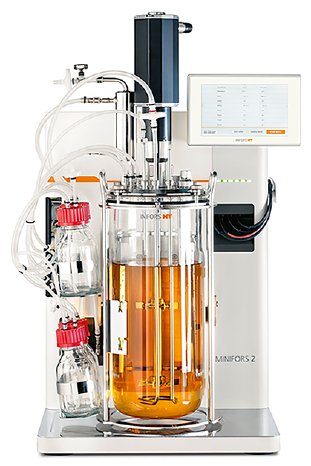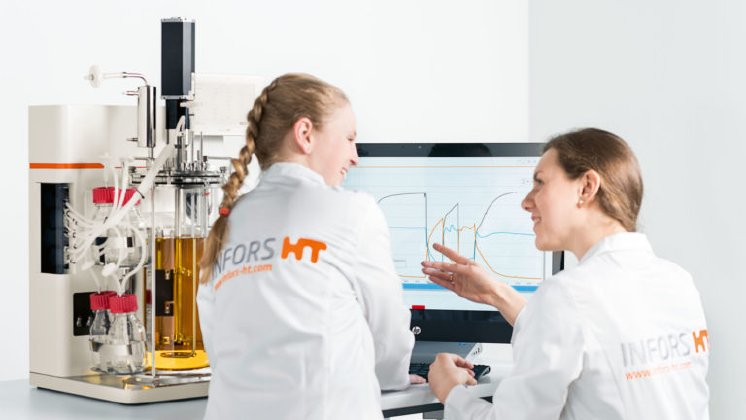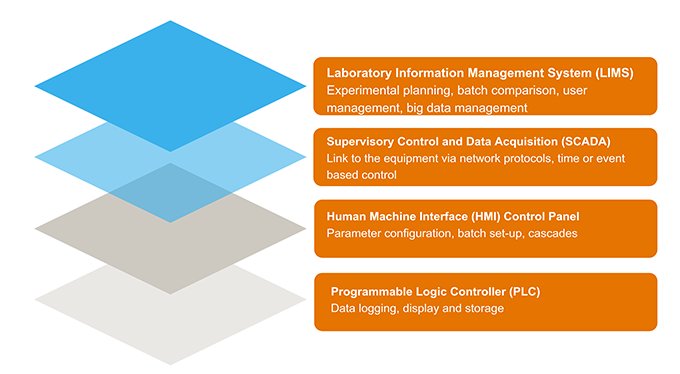1. Levels of a Bioprocess Software
By its nature, bioprocess software is multi-layered. Different categories of users have layers in terms of the features they need from bioprocess software:
- Those users with the basic needs may only require the software features integrated into the bioreactor
- Most users will require the extra capability provided by external bioprocess software
- Some advanced users may need specific features beyond the standard software package, such as process validation via advanced user management and additinal security features.
Each choice of bioprocess software level will have its own license and related costs. Upgrading is always an option but getting the decision right the first time is preferable. Creating a User Requirement Specification (URS) will help you to define your specific needs: Divide a list of available features into must have, should have and could have categories, then the different software levels can be compared to your list in an objective way. Other stakeholder’s opinions, budget, timing and futureproofing will also play a part in the decision-making process.
The user categories will now be explored in more detail to provide a better idea of how to get the most from each software level. This will help you decide on initial choices if and when to upgrade and to which level. For many users, the decision will be made by the application and process itself.
3. User types
3.1 Basic User
A basic user has no perceived need for specialised biprocess software. Any modern HMI will have elements built-in for local control, but this will not be as comprehensive as a bioprocess software solution. The advantages of keeping all bioprocess data in one place, including analysis results and message logs, are easy to identify.
Basic requirements include:
- Output of process values plus set points and controller status
- Display real-time data as text and/or charts
- Start and stop batches
- Log data for a limited timeframe and archive to external memory
- Display alarms and archive to external memory
- Export data t in Comma Separated Value or Excel file formats
- Store used setting and/or recipe files
This group can be best described as thise whose needs are met by the standard features provided. The fact that many popular features are included in a “standard version” is the reason why it is a clear leader in numeric terms. Although, it is likely that an upgrade will be necessary in the future.
A typical standard user would need the basics plus some combination of the following:
- Analysis values (including addition of data post-archive)
- Comparison of real-time and archived batches
- Export of data over a network
- Printing of charts
- Connection of peripherals
- Calculated values
- Time-based control in phases
- Simple cascades
- Feeding in different steps
- Pump timings recorded
- Store control sequence files
- Multi-vessel logging/control
- Connection to third-party devices for mixed installations
This category equates to full SCADA software plus advanced features related to the whole bioprocess. The type of features which could be included in this group are
- Offers customisation possibilities
- Multiple set up of batches simultaneously
- Full reporting with the output of alarms, recipes, soft sensors and workflows.
- Data supplied in real time to other laboratory software packages
- Full documentation provided for validation, QC and scale-up purposes
- Integration with other software for specific purposes e.g. modelling in Matlab.
- Central location for data and meta-data including libraries for organisms, culture media and recipes.
- Multi-group planning capabilities
3.4 Super Users
This is usually the domain of industrial users and may tie together research, scale-up and production facilities. Any process for clinical applications will need a range of qualification documents for process validation. Regulatory authorities will also need to access the data. However, some universities and institutes may have large projects which need the same level of co-ordination. The type of features which could be included in this group are
- Multi-user with a mix of HMI and software for peripherals to be integrated
- May also be multi-user and may be multi-site
- Numbers of real-time links in the high tens of units
- Well-specified server(s) needed
- For use within an industrial or Contract Manufacturing Organisation
This article has explored different layers of bioprocess software how they can be mapped onto the diverse needs of users.
- A basic user may be able to manage his bioprocess with a local HMI controller and may not require external software, although they would miss out on advanced automation, archiving and data analysis.
- A standard user should be well served by a standard software package by using what is needed for their application and ignoring the rest. This will suit most users, but in order to progress, a future upgrade may be required.
- An advanced user package equates to the needs of process validation and working across several groups. The concept of the process is a big element, with many elements defined and stored in libraries within the bioprocess software.
- The super-user is a rarest category, involving large projects and customized approach. Multi-group and multi-site operation are the key. As tens of bioreactors may be connected at one time, security and reliability are paramount.







